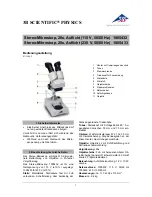
3
BX53
2
Maintenance and Storage
1. To clean the lenses and other glass components, simply blow dirt away using a commercially available blower and wipe
gently using a piece of cleaning paper (or clean gauze).
If a lens is stained with fingerprints or oil smudges, wipe it gauze slightly moistened with commercially available absolute
alcohol.
·
Since the absolute alcohol is highly flammable, it must be handled carefully.
Be sure to keep it away from open flames or potential sources of electrical sparks --- for example, electrical
equipment that is being switched on or off, which could cause ignition of a fire.
Also remember to always use it only in a well-ventilated room.
·
Set the main switch to “ ” (OFF) and wait for the lamp housing to cool down sufficiently before proceeding
to maintenance.
2. Do not use organic solvents to clean the microscope components other than the glass components. To clean them,
use a lint-free, soft cloth slightly moistened with a diluted neutral detergent.
3. Do not disassemble any part of the microscope except for the parts that are specified to be disassembled in this manual,
as this could result in malfunction or reduced performance.
4. After using the microscope, set the main switch to “ ” (OFF), wait for the lamp housing to cool down sufficiently, and
keep it covered with a dust cover during storage.
5. Before disposing of this product, be sure to follow the regulations and rules of your local government.
3
Caution
If the microscope is used in a manner not specified by this manual, the safety of the user may be imperiled. In addition,
the equipment may also be damaged. Always use the equipment as outlined in this instruction manual.
The following symbols are used to set off text in this instruction manual.
: Indicates a potentially hazardous situation which, if not avoided, may result in minor
or moderate injury or damage to the equipment or other property. It may also be used
to alert against unsafe practices.
}
: Indicates commentary (for ease of operation and maintenance).
4
Intended use
This instrument has been designed to be used to observe magnified images of specimens in various routine work and
research applications.
Do not use this instrument for any purpose other than its intended use.
This instrument is considered a medical device in the following countries: US, and China.
This device complies with the requirements of directive 98/79/EC concerning in vitro diagnostic
medical devices. CE marking means the conformity to the directive.
CAUTION
CAUTION








































